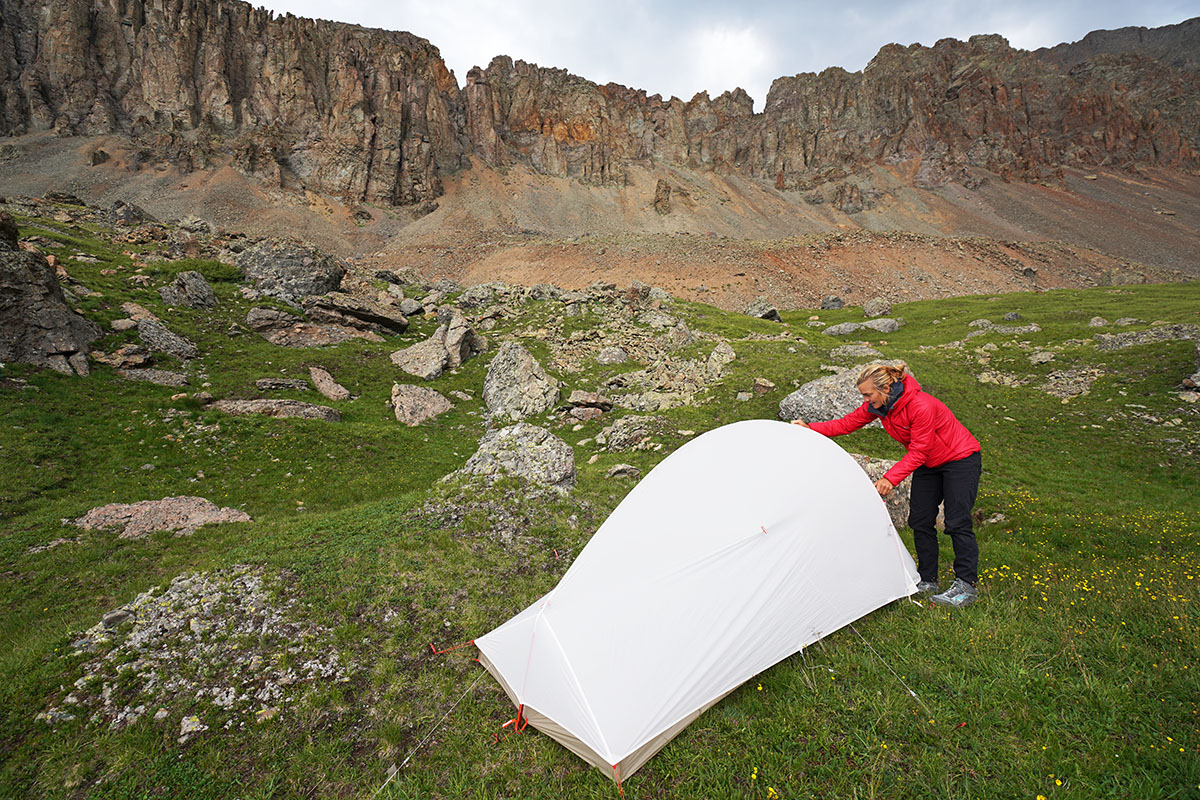
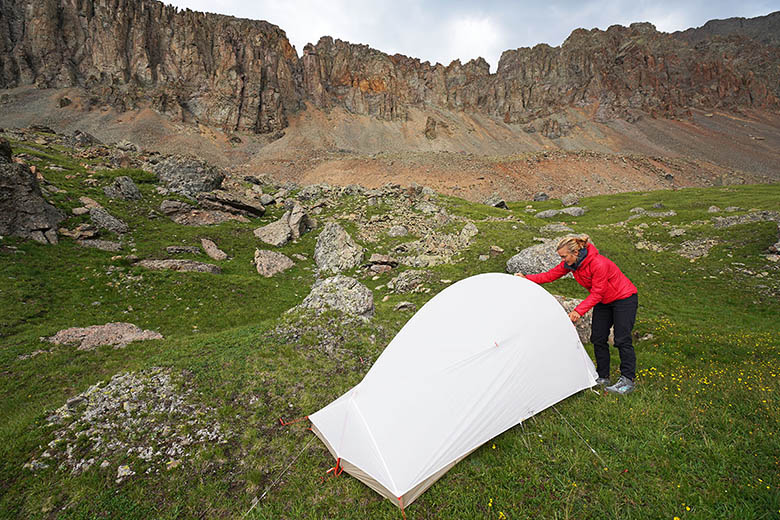
Switchback Travel (Jason Hummel)
Price: $400
Packaged weight: 2 lbs. 4 oz. (2P)
Floor area: 28 sq. ft.
Capacities: 1P, 2P
What we like: Truly ultralight at a competitive price.
What we don’t: One door/vestibule layout limits practicality; not suitable for very inclement weather.
See the Big Agnes Fly Creek HV UL2
In many ways, Big Agnes’ Fly Creek helped bring the ultralight movement to the mainstream. At under 2.5 pounds, it’s comparable to a bivy sack or hammock and stuffs down impressively small in a pack. Recently retooled with a solution-dyed fabric, streamlined pole clip system, steeper walls, and larger entryway, we put the latest version of the tent to the test in Colorado’s San Juans and Washington’s Cascade mountains. The verdict: while it’s still a leading UL design, the Fly Creek does come with notable compromises in interior space, storage, and weather protection. Below we break down the Fly Creek’s overall performance. To see how it stacks up to the competition, see our articles on the best backpacking tents and best ultralight tents.
Tents are one of the first pieces of gear backpackers look to in order to cut weight, and the Big Agnes Fly Creek HV UL2 Solution Dye delivers at just 2 pounds 4 ounces all in. In terms of competition, Big Agnes’ own Tiger Wall UL2 (2 lbs. 8 oz.), Nemo’s Hornet (2 lbs. 6 oz.), and REI’s Flash Air 2 (2 lbs. 8 oz) clock in slightly heavier, although all three feature two-door-and-vestibule layouts that add a great deal of convenience (the Fly Creek has just one door and vestibule). Nemo’s Hornet Elite (2 lbs. 1 oz.) is one of few ultralight models to undercut the Fly Creek, but the fabrics are concerningly thin, and the tent won’t hold up in truly rough conditions (plus, it’s much pricier at $500). Zpacks’ Duplex (1 lb. 3 oz.) is another popular option among thru-hikers, but its trekking pole-supported design isn’t as user-friendly, and you pay a steep premium ($649) for the Dyneema fabrics. All in all, the Fly Creek is a solid value for a proven UL design.
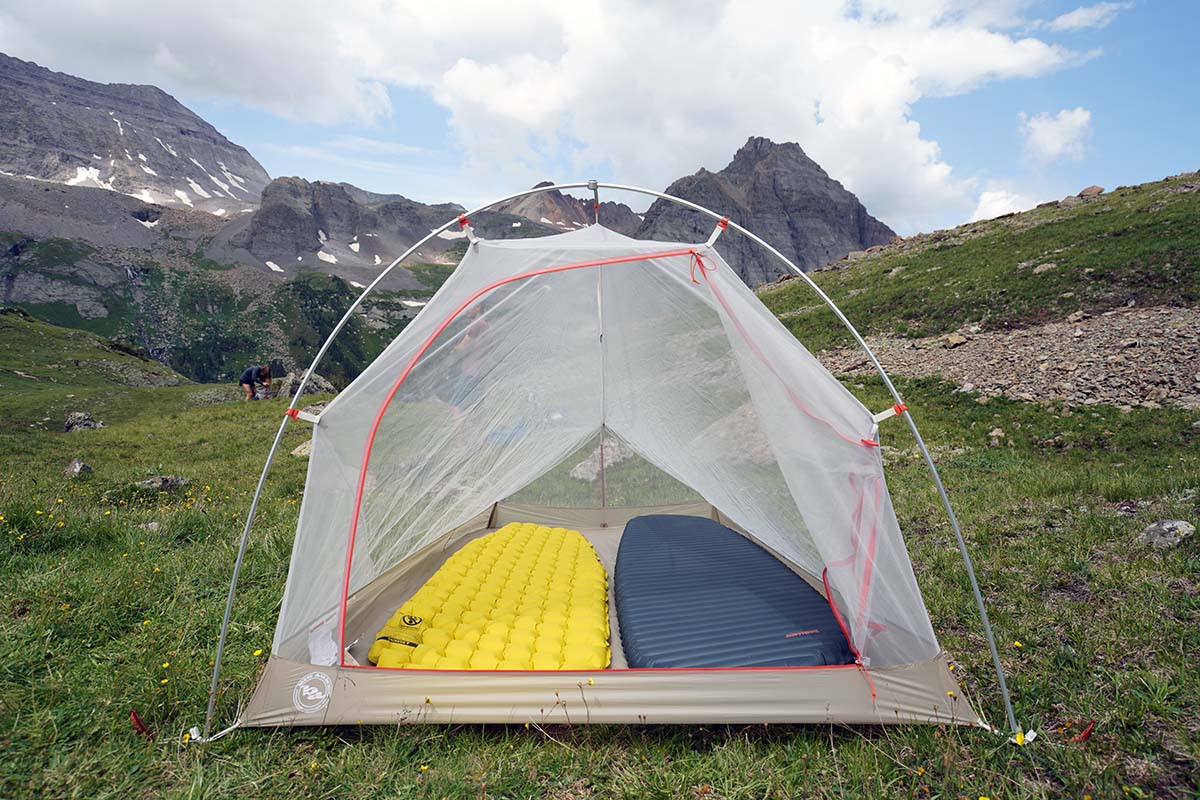
Lining up with its weight, the Fly Creek’s simplistic pole structure and thinner materials allow it to pack down to a relatively tidy shape that stuffs fairly easily into a pack. However, it’s worth noting that the latest Solution Dye model is larger than its predecessor, with a 6 x 19.5-inch shape that’s larger than much of its competition (the previous model measured 4 x 19 in.). For comparison, it’s bulkier than almost all of the aforementioned competitors, including the Big Agnes Tiger Wall (5.5 x 18), Nemo Hornet (5.5 x 19.5), REI Co-op Flash Air (7 x 16), and Nemo Hornet Elite (4.5 x 19). But to be fair, the Fly Creek still stuffs down to a pretty diminutive size, and most backpackers should have no issue finding room for it (you can always separate the pole bag from the rest of the tent to maximize space in your pack).
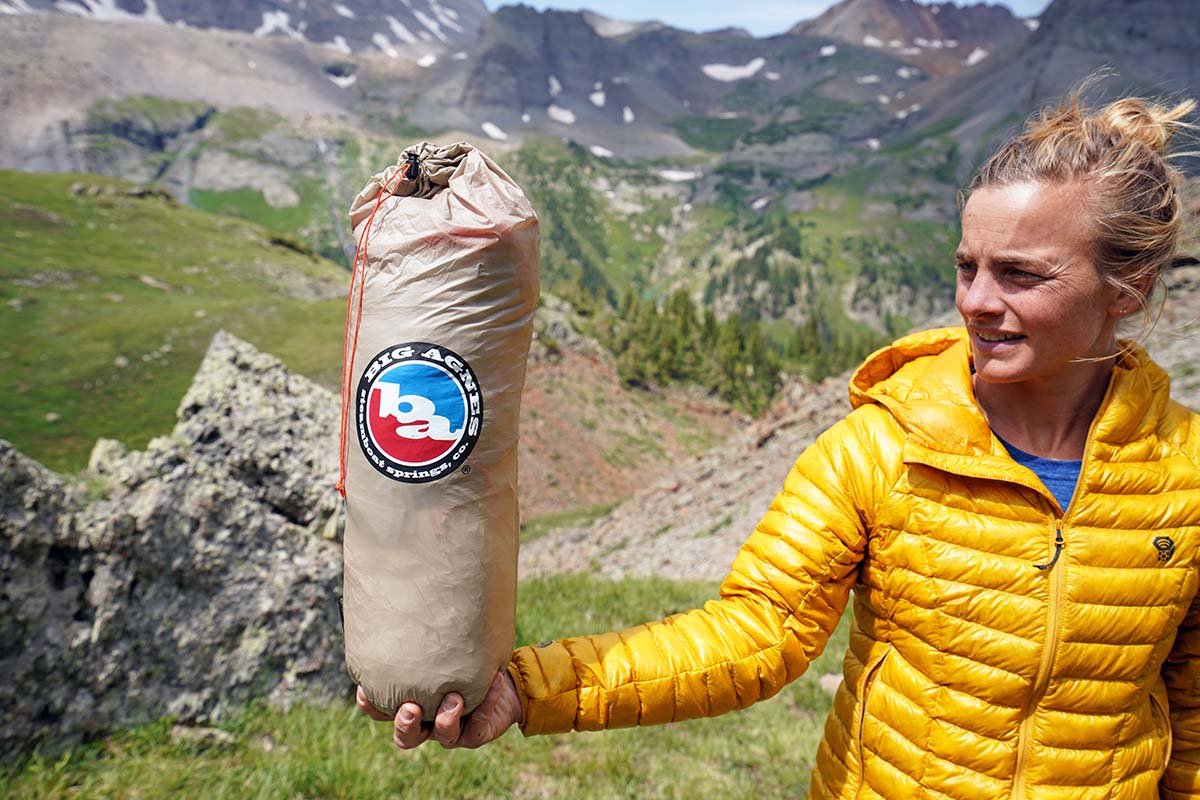
Without a doubt, one of the biggest compromises in choosing the Big Agnes Fly Creek HV UL2 is interior space. Put simply, the UL2 version is best used as a solo tent. You do get decent head room at 42 inches (2 in. more than its predecessor) due to the tilted hubbed pole above the door and steeper walls (hence the “HV,” or high-volume, in the name). However, the tapered shape means it can hardly fit two regular-width (20-in.) sleeping pads without some overlap (you’ll want a mummy-shaped pad), and the tapering at the foot end makes it nearly impossible to sleep head-to-toe with your tentmate. In the end, our take is that the Fly Creek is a solid setup for one (provided you sleep in the middle) but a pinched space for two adults.
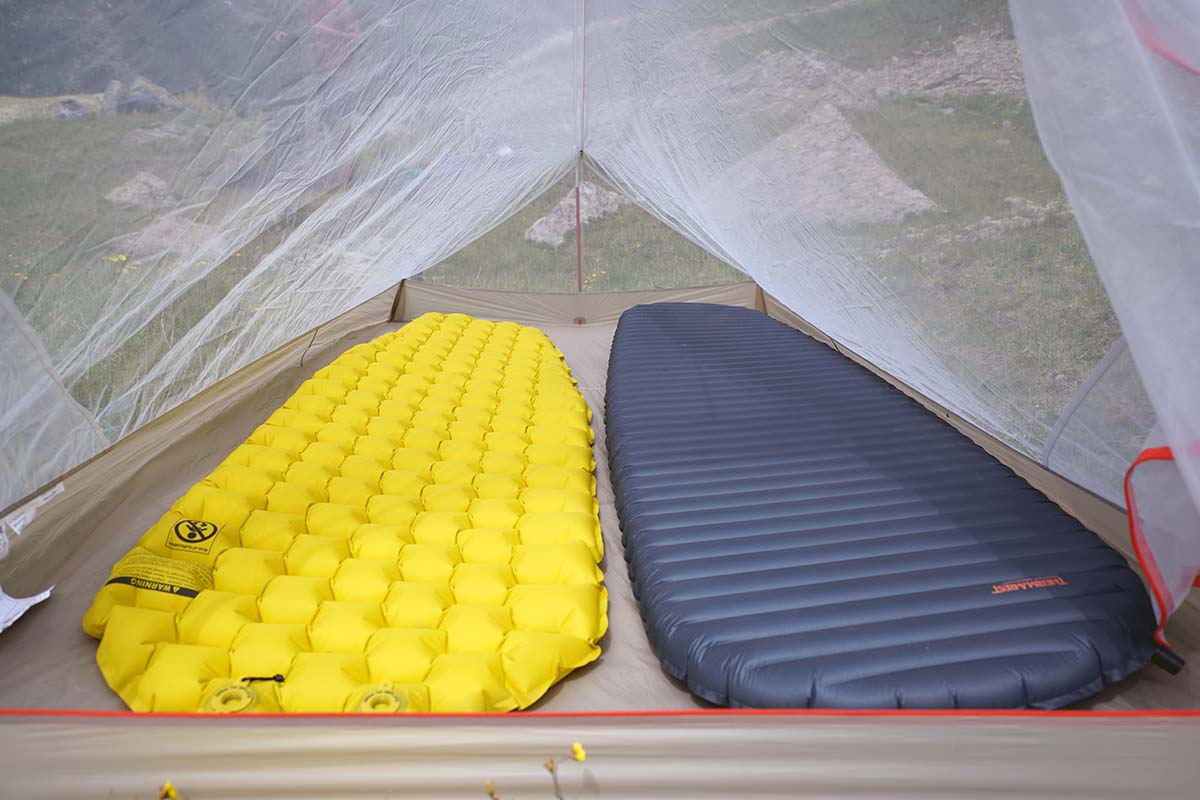
Like many ultralight tents, the Fly Creek sacrifices a considerable amount of durability in order to keep weight low. The included DAC Featherlite poles aren’t as strong as heavier varieties, the 15-denier (D) rainfly is partially transparent, and the 20D floor certainly requires extra care (Big Agnes sells a footprint for $75, or you can go the budget route with a standard polypro ground cloth). But despite these compromises, it’s important to point out that the Fly Creek is pretty average in the UL market, and plenty of tents in the same weight class use even thinner fabrics, including REI’s Flash Air with a 15D floor and Nemo’s Elite line with 10D floors.
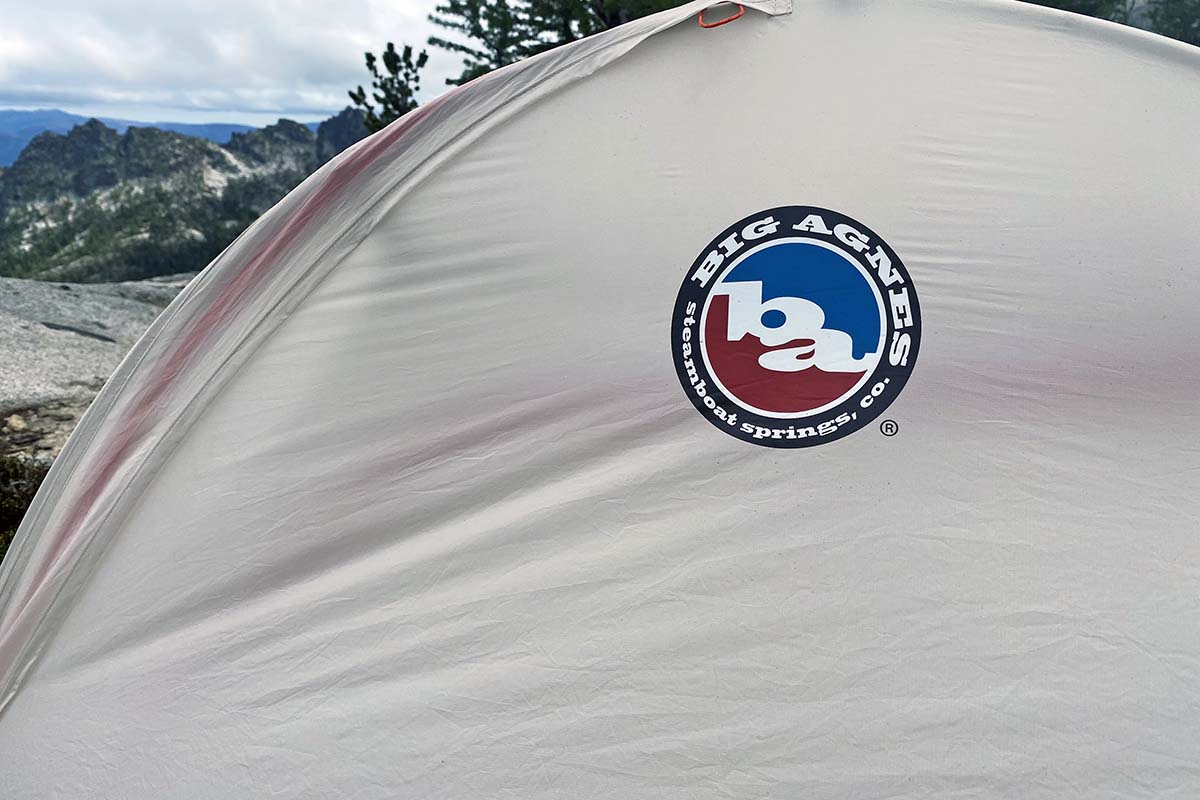
To really put the tent’s durability to the test, I took the Fly Creek into very windy conditions in Washington State’s Enchantments. At one point, a strong gust entered the partially unzipped vestibule, turned the tent into a sail, and snapped a pole in half (which then proceeded to puncture the fly). This likely wouldn’t have happened had I kept the vestibule fully closed, but a sturdier tent certainly would have held up better in the same weather. It's important to note that our experience with Big Agnes' customer service was excellent: they facilitated a repair of our pole (turnaround time was roughly 2 months) and provided instructions on how to patch the rain fly. From a sustainability standpoint, we really appreciate that they aim to repair rather than replace tent parts, which mitigates waste and needless shipping fees.
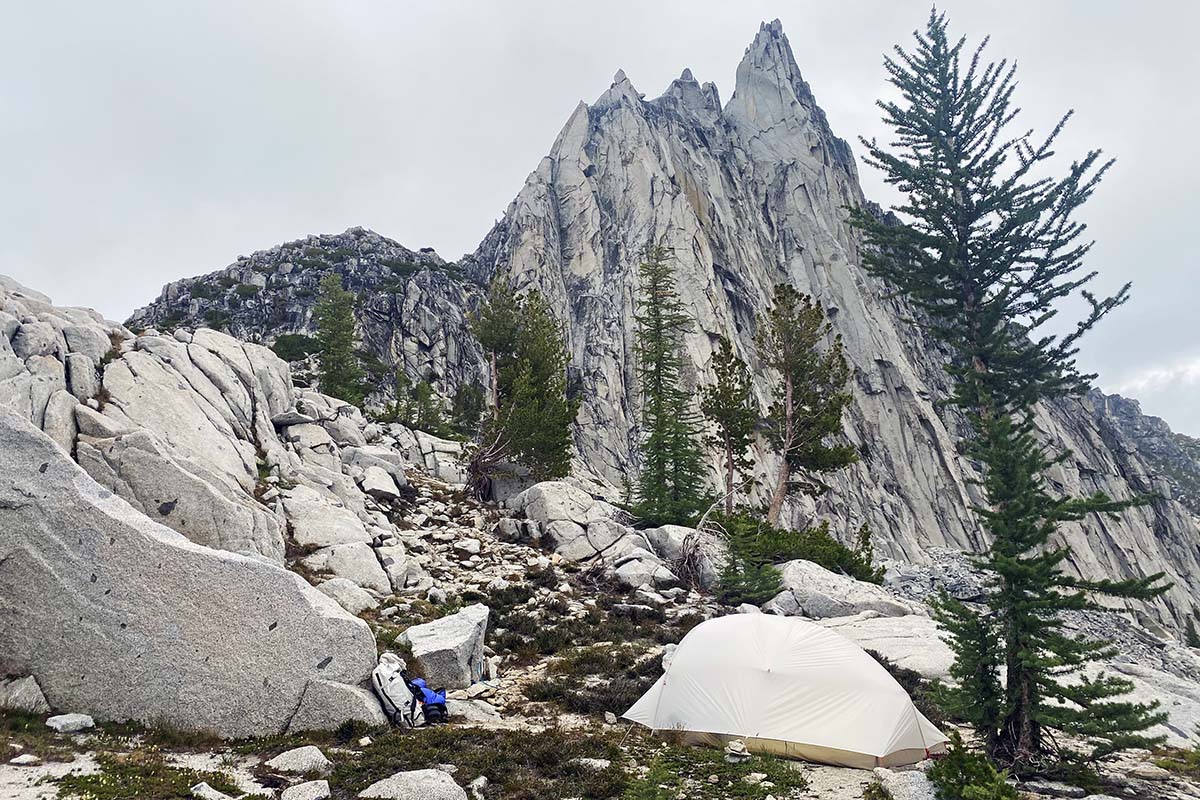
The Big Agnes Fly Creek HV UL2 is listed as a 3-season backpacking tent, which technically means it should get the job done in spring, summer, and fall conditions. That said, after a full summer of testing, I’m hesitant to recommend it for anything other than mild conditions. First and foremost, the Fly Creek struggles in heavy rain. While you do get a full-coverage rainfly and quality seam sealing (not always the case in the ultralight market), the tent has limited structure and support. With just a single pole running down the spine, the fly has a tendency to press up against the sides of the tent, which can cause water to seep through the mesh canopy walls. To mitigate this, you’ll want to be sure to fully guy out the Fly Creek, including the midpoint sections on the fly.
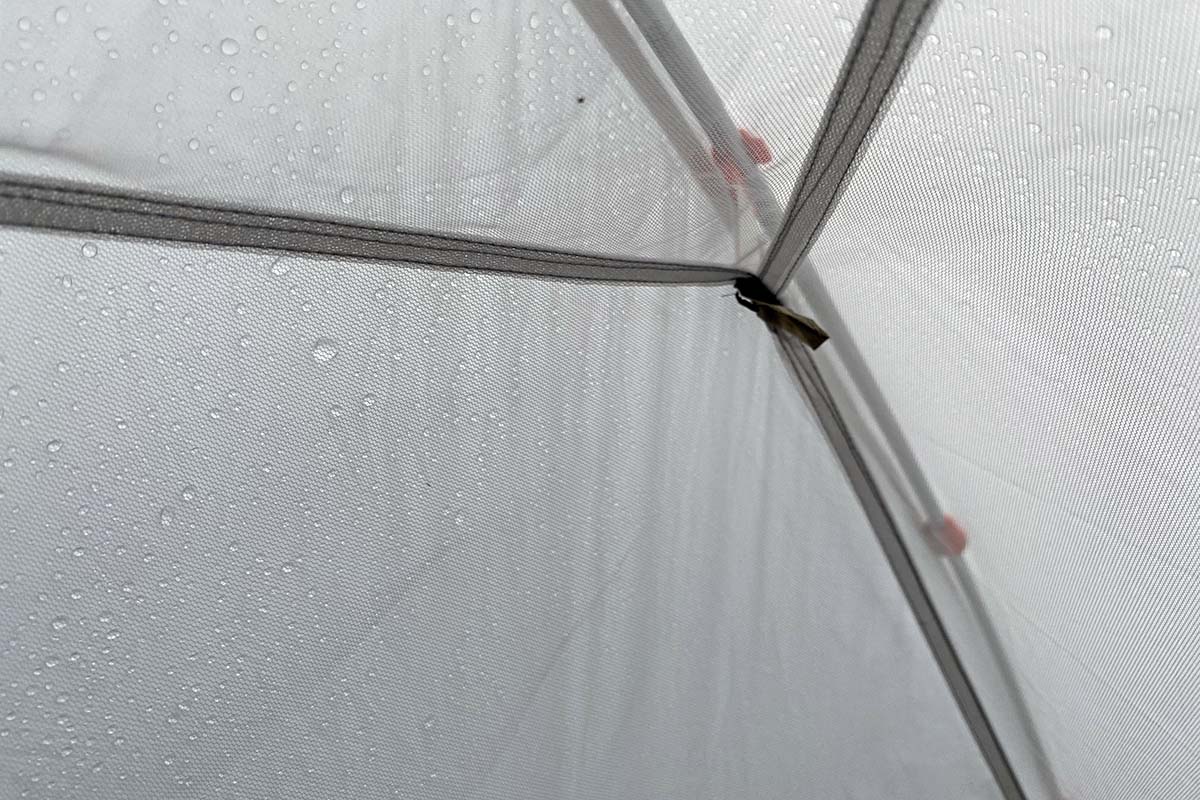
Unfortunately, wind protection is even worse due to the single-pole structure and mesh-heavy build. During our night of strong winds in the Enchantments, the Fly Creek consistently caved in from both sides, and dirt crept through the gap between the rainfly and body, piling up on our sleeping bags, sleeping pads, and faces. All told, if you anticipate frequenting gusty conditions, I recommend opting for a design with less mesh, taller bathtub floors, and a crisscrossing pole structure like Big Agnes’ own Copper Spur (even the center ridge pole of the Tiger Wall would add some stability). Single-wall tents tend to be the best performers in this regard with little to no mesh, although the tradeoff is considerably less breathability.
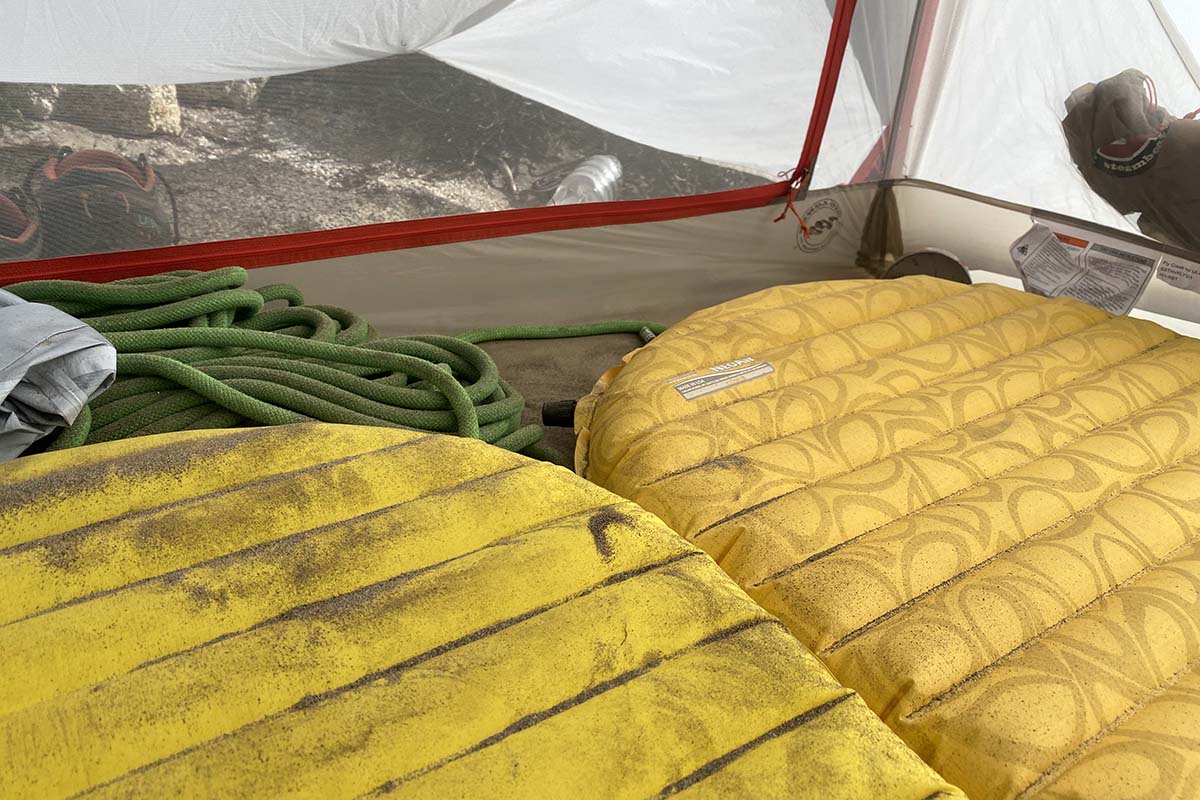
The flipside to the Fly Creek’s compromised weather protection is excellent ventilation. The generous use of mesh and double-wall construction allow air to flow freely between the rainfly and the tent body, mitigating moisture buildup. Key to this is getting a taut and fully guyed-out pitch, which prevents the sidewalls from sagging and maintains separation between the fly and canopy. We would love to see Big Agnes add a built-in roof vent to further boost airflow, but the Fly Creek, nevertheless, is a decent overall breather considering its ultralight build, especially when compared with single-wall competitors.
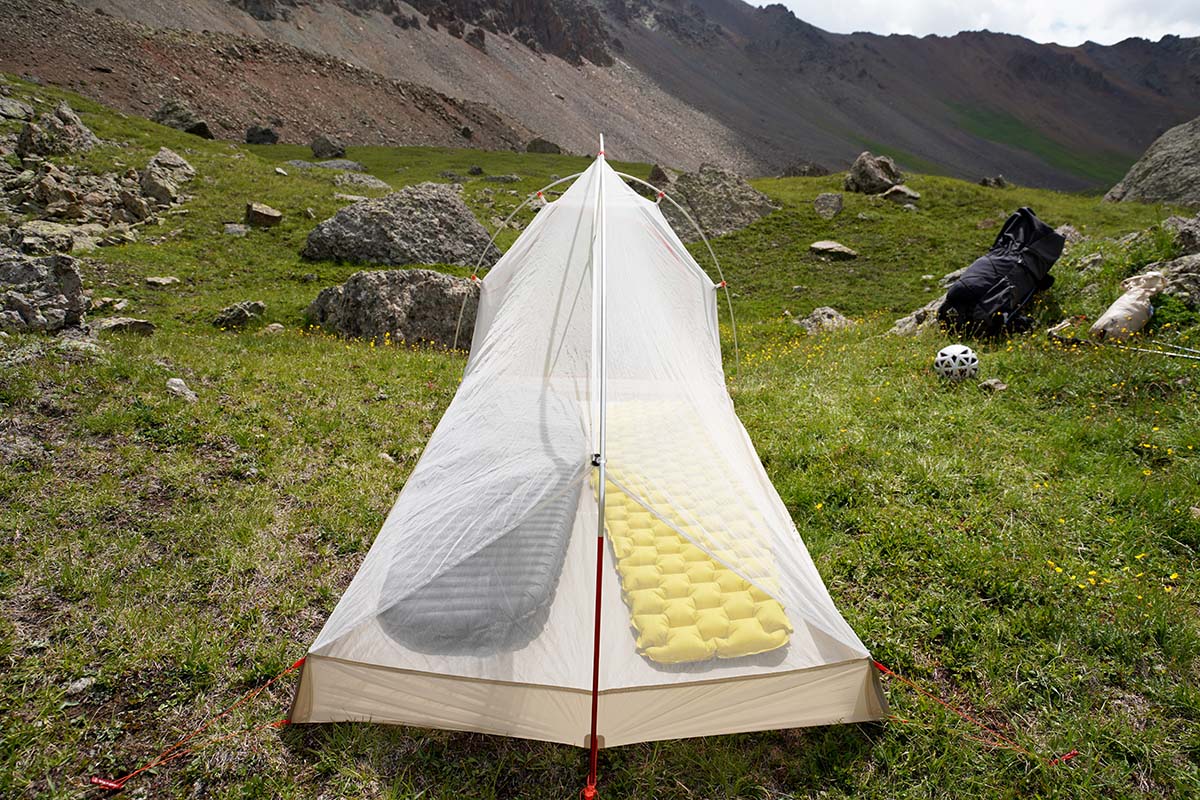
One major way Big Agnes cut down on weight with the Fly Creek HV UL2 was by using a single door and vestibule at the head end of the tent. We prefer this layout to a single side door, which can create challenges getting in and out of the tent when camping with a partner. That said, it’s still not our favorite setup. Putting your backpacking pack in front of the door blocks access, and it can be downright tricky to navigate the various footwear and gear in front when entering and exiting. Single backpackers might not mind, but even on solo trips, we prefer the convenience of two vestibules so that we can dedicate one solely to gear. The good news is that the vestibule door opening is very wide (and now taller with the latest update), and rolling it back is a nice way to let in light in fair weather. Plus, interior storage is decent: there is a triangular pocket by the head at each side and a larger pocket along the roof, although we found the latter to be prohibitively shallow—it consistently ejected our phone and headlamp onto the bed below.
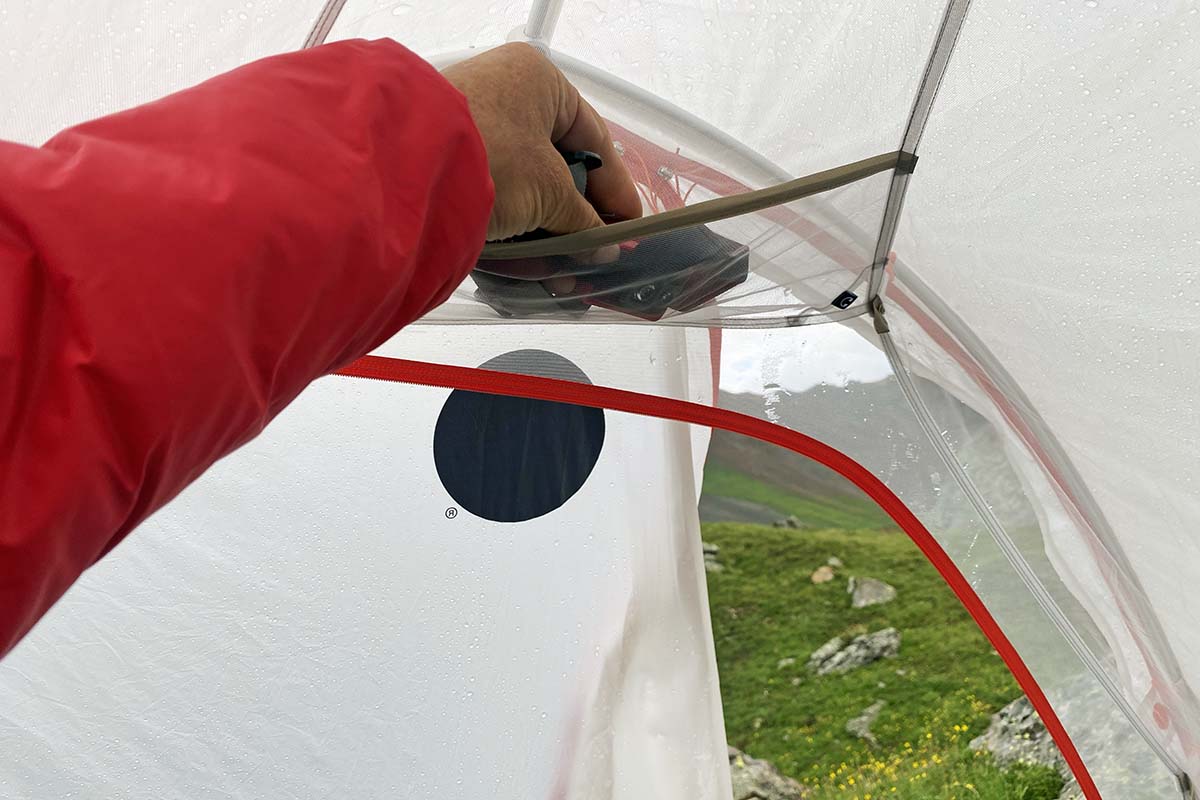
With only one hubbed pole, the Fly Creek’s set-up process is fairly simple: simply insert the three pole ends into two grommets at the head and one at the foot. Due to the tent’s semi-freestanding design, it’s also important to stake or guy out the two corners at the foot end. This requires that you pitch your tent on a reliable surface where you can securely drive stakes into the ground or bring extra guylines to secure the corners to rocks or trees. And as I noted above, you’ll also want to guy out the tent at all other points to maximize ventilation and weather protection. But even with these added steps, the Fly Creek still is simpler and easier to set up than non-freestanding UL builds like the Zpacks Duplex.
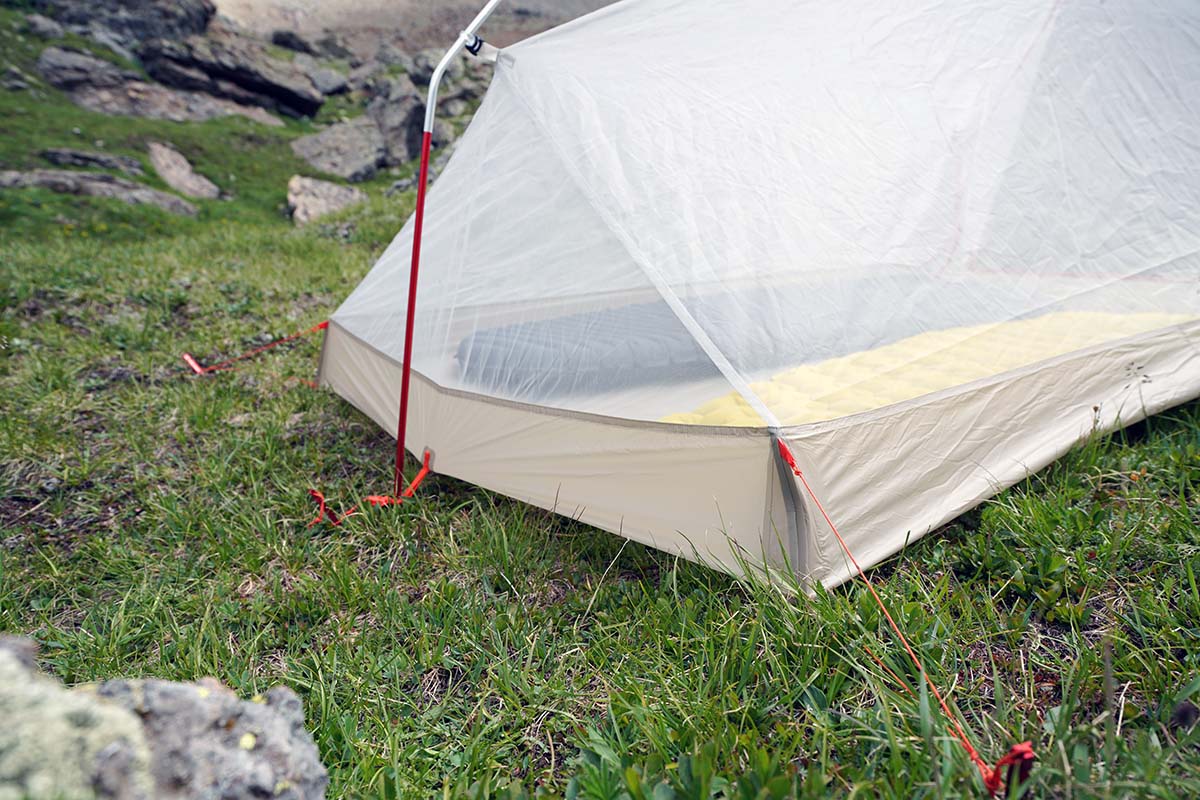
The Fly Creek HV UL2 is now made with solution-dyed fabric, which uses less water and energy during production, is more UV-resistant, and is less prone to fading over time. Further, the DAC poles can be recycled at the end of their lifespan and are anodized in a way that minimizes fuel and energy consumption. Finally, Big Agnes is now part of the Outdoor Industry Association’s Climate Action Corps, and each of their three U.S. facilities operates via 100 percent renewable electric energy. While the best thing you can do for the planet is reduce your consumption and use what you already have, we appreciate Big Agnes’ efforts towards more sustainable and environmentally friendly manufacturing.
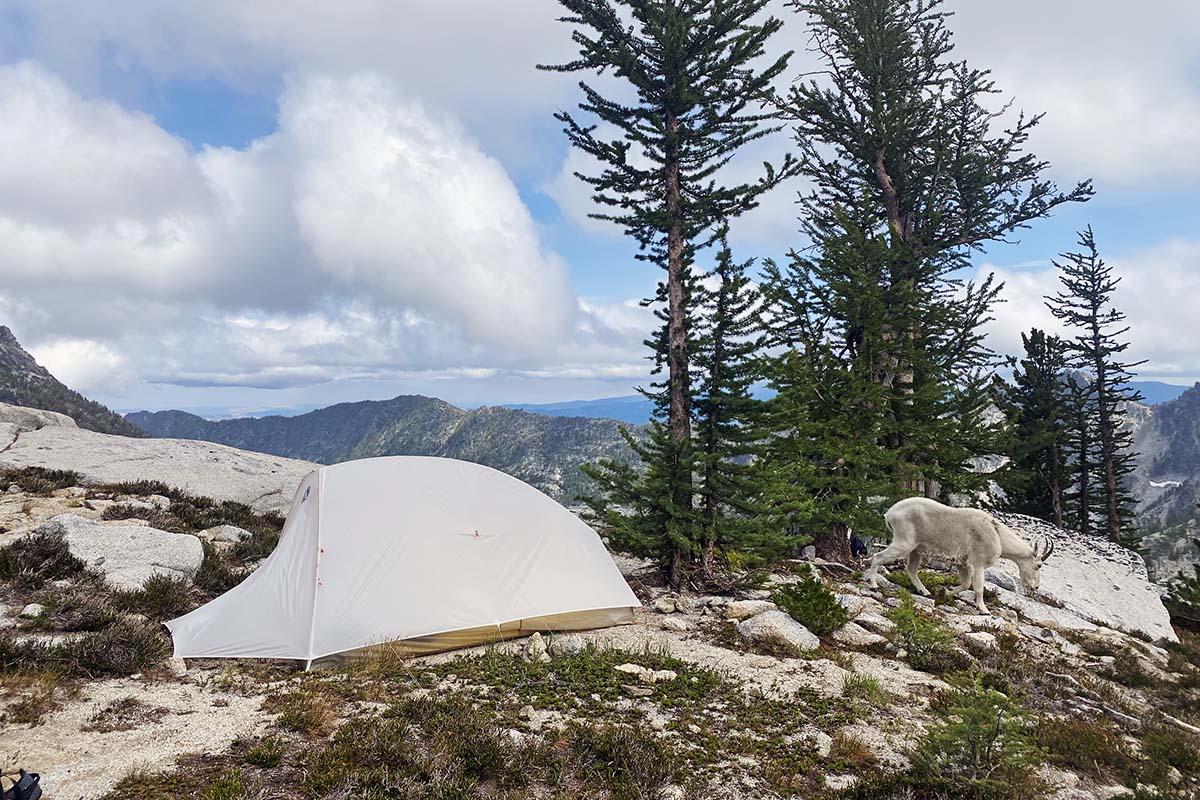
We tested the two-person version of the Fly Creek HV UL, and Big Agnes also makes the tent in a one-person model. The Fly Creek HV UL1 shares most of the design features of the 2P tested here in a trimmed-down shape and lighter-weight package (2 lbs). However, given the UL2’s feathery build, we think the added space is worth it, even for solo backpackers. And rounding out the collection, Big Agnes also makes ultralight Platinum and Carbon models in one- and two-person capacities. The Platinum uses even thinner nylon fabrics, while the Carbon utilizes Dyneema and carbon fiber poles for a crazy low 1-pound-7-ounce weight for the 2P (at a whopping $850).
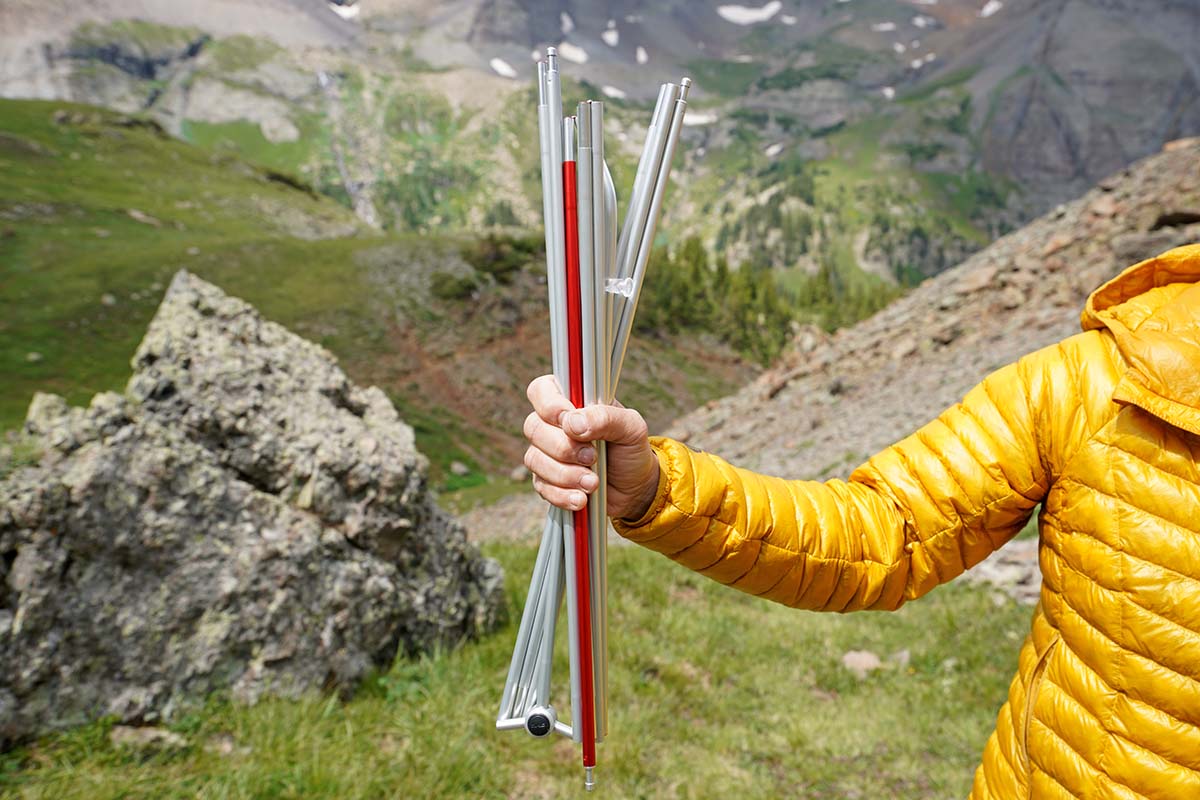
| Tent | Price | Weight | Area | Floor | Height | Door(s) | Capacities |
|---|---|---|---|---|---|---|---|
| Big Agnes Fly Creek HV UL2 | $370 | 2 lbs. 4 oz. | 28 sq. ft. | 20D | 42 in. | 1 | 1P, 2P |
| Nemo Hornet 2P | $370 | 2 lbs. 6 oz. | 27.5 sq. ft. | 15D | 39 in. | 2 | 1P, 2P |
| Big Agnes Tiger Wall UL2 | $400 | 2 lbs. 8 oz. | 28 sq. ft. | 15D | 39 in. | 2 | 2P, 3P |
| REI Co-op Flash Air 2 | $299 | 2 lbs. 8 oz. | 28.7 sq. ft. | 15D | 42 in. | 2 | 1P, 2P |
| Tarptent Double Rainbow | $319 | 2 lbs. 10 oz. | 30.6 sq. ft. | 30D | 40 in. | 2 | 1P, 2P |
| Zpacks Duplex | $649 | 1 lb. 3 oz. | 28 sq. ft. | 1 oz./sqyd | 48 in. | 2 | 1P, 2P, 3P |
Big Agnes’ Fly Creek HV UL2 is a leading ultralight backpacking tent for its feathery build, double-wall construction, and competitive price. Its closest competitor in the UL category is Nemo’s Hornet 2P. The tents are nearly identical in weight (the Fly Creek wins out by 2 oz.), durability (the Nemo uses 10 and 15D fabrics while the Big Agnes uses 15 and 20D), build quality, and similarly tight quarters inside. Further, both excel for solo backpackers despite their two-person designations. That said, the Hornet is the more convenient option thanks to its two door/vestibule layout, which makes it feel less claustrophobic overall. All in all, given the similarity in weight and identical cost, we give the edge to the Hornet for its less compromised build.
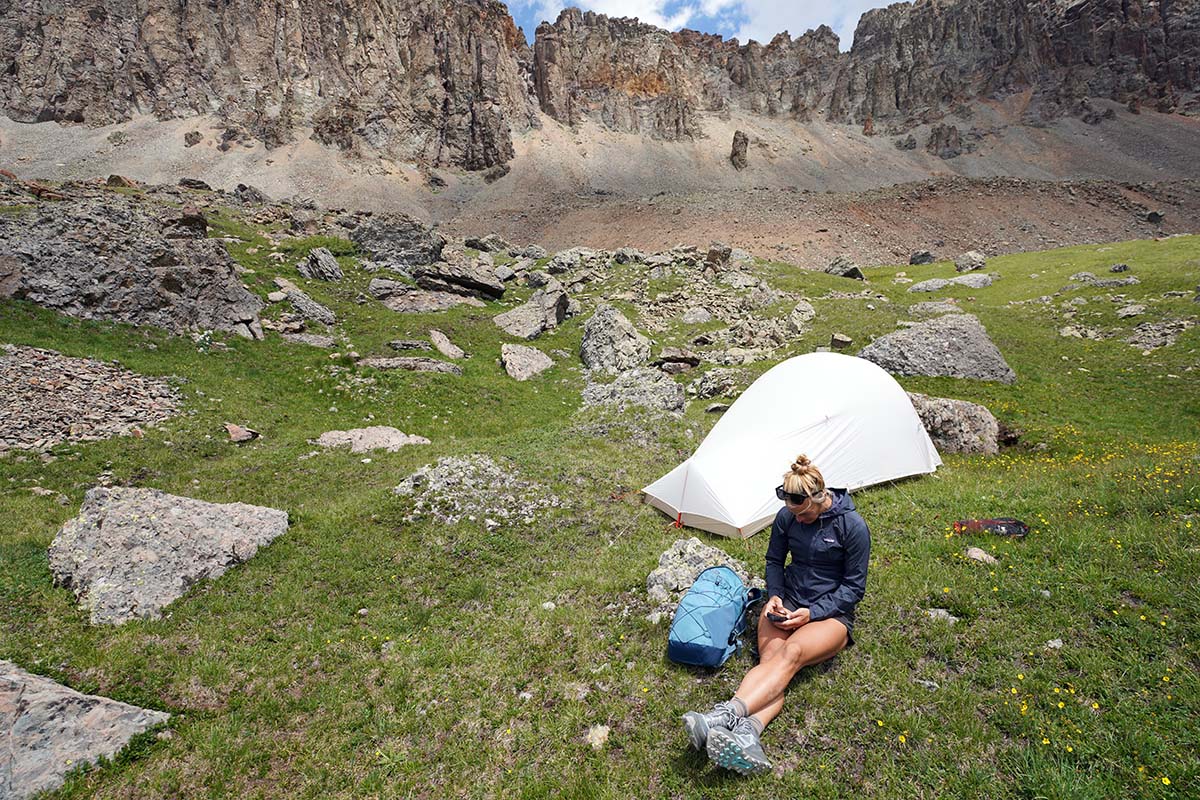
Big Agnes’ own Tiger Wall is an interesting alternative to consider, combining design elements of the Fly Creek and the more feature-rich and spacious Copper Spur. Like the Fly Creek, the Tiger Wall UL2 now uses a solution-dyed fabric and is semi-freestanding but adds a center ridge pole and two door/vestibule layout that greatly improves livability and stability in high winds. The Tiger Wall is still fairly snug inside despite these additions (it has the same square footage), although it can accommodate two backpackers much more easily than the Fly Creek. All in all, the Tiger Wall strikes us as the better-balanced build, especially given that it only weighs an additional 4 ounces.
REI Co-op jumped into the UL tent world with their Flash Air, which features a unique, non-freestanding build that uses two side poles (swapping them for trekking poles saves another 3.4 oz.) to create its structure. The Fly Creek beats it in weight by 4 ounces and is a bit faster to set up with its semi-freestanding design, but the Flash Air 2 still is reasonably quick and very user-friendly; plus it’s slightly roomier inside with 28.7 square feet of floor area (compared to the Fly Creek’s 28 sq. ft.). All in all, the Flash Air is the much better choice for two backpackers, and we think even single backpackers will appreciate the REI’s two door/vestibule layout and larger interior dimensions (not to mention, you save around $70 with the Flash Air).
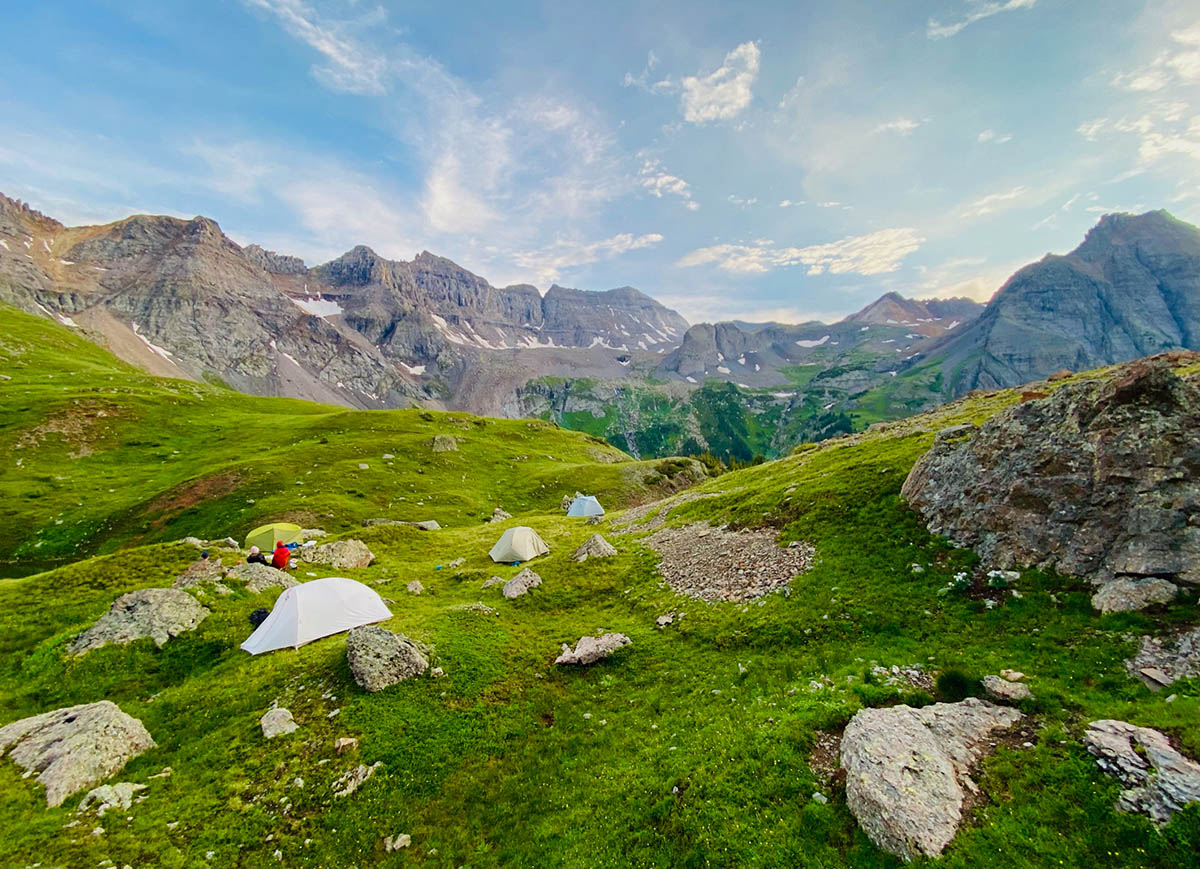
Moving into the cottage tent industry, the Tarptent Double Rainbow is another quality UL design to consider. Stacked up to the Fly Creek, the Tarptent is more affordable at $319 but weighs considerably more at 2 pounds 10 ounces all in (including poles, stakes, and the stuff sack) and uses a non-freestanding construction. The Tarptent’s hybrid single-wall build also makes it more prone to moisture buildup, and the Double Rainbow doesn’t come with sealed seams (you can pay for this service from Tarptent for an additional $35). In the end, the Double Rainbow is cheaper, more durable, and better in wind than the Fly Creek, but the Big Agnes wins out in almost every other category.
A final competitor is one of the few to beat the Fly Creek in weight: the Zpacks Duplex. The trekking pole-supported design weighs in at just 1 pound 3 ounces (not including stakes) and is popular among the thru-hiking crowd. However, its single-wall build means it suffers more with condensation than the Fly Creek, and the fully Dyneema construction comes at a steep price ($649 for just the tent, plus the cost of stakes, trekking or tent poles, etc.). Given the design, the Duplex also takes more effort and time to get a good pitch compared with the more user-friendly Fly Creek, although it’s more spacious inside while easily winning out in weight. All things considered, the Zpacks isn’t for everyone, but its weight-to-space ratio is hard to beat.
If you’re thinking about buying gear that we’ve reviewed on Switchback Travel, you can help support us in the process. Just click on any of the seller links above, and if you make a purchase, we receive a small percentage of the transaction. The cost of the product is the same to you but this helps us continue to test and write about outdoor gear. Thanks and we appreciate your support!
Depending on the seller, most products ship free in the United States on orders of $50 or more. International shipping availability and rates vary by seller. The pricing information on this page is updated hourly but we are not responsible for inaccuracies.